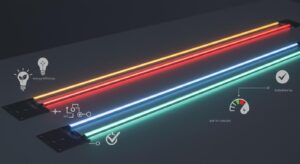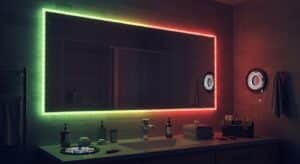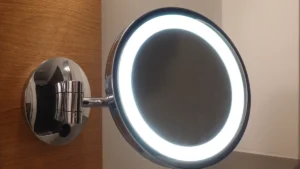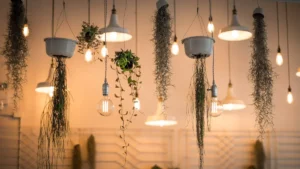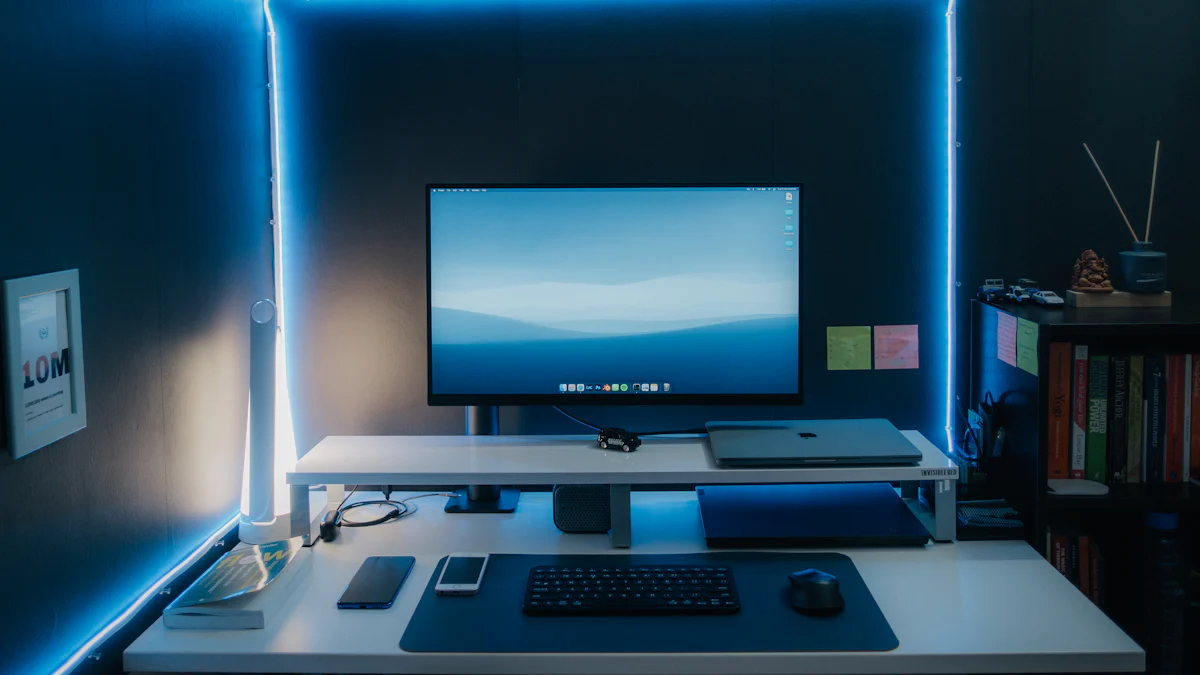
Selecting the perfect RGB LED strip can transform your space with vibrant and functional lighting. These strips offer unmatched versatility, making them ideal for both decorative and practical applications. To achieve the best results, you must focus on factors like the type of strip, its features, and the installation environment. High-quality LED strips ensure better brightness, durability, and color accuracy. By choosing the right LED strip tailored to your needs, you can create stunning visual effects while maintaining optimal performance. Whether for home, office, or outdoor use, suitable LED strip lights elevate the ambiance effortlessly.
Key Takeaways
Understand the different types of RGB LED strips—Standard, RGBW, and Addressable—to choose the best fit for your lighting needs.
Consider key features like brightness, color accuracy, and waterproofing to ensure optimal performance and longevity of your LED strips.
Select a suitable power supply that matches the voltage and wattage requirements of your LED strip to prevent damage and ensure reliable operation.
For indoor installations, prioritize energy efficiency and ease of installation to create a functional and visually appealing environment.
When installing LED strips, measure accurately, clean surfaces, and test connections to achieve a seamless setup.
Regular maintenance, including cleaning and inspecting connections, helps prolong the lifespan and performance of your LED strip lights.
Types of RGB LED Strips
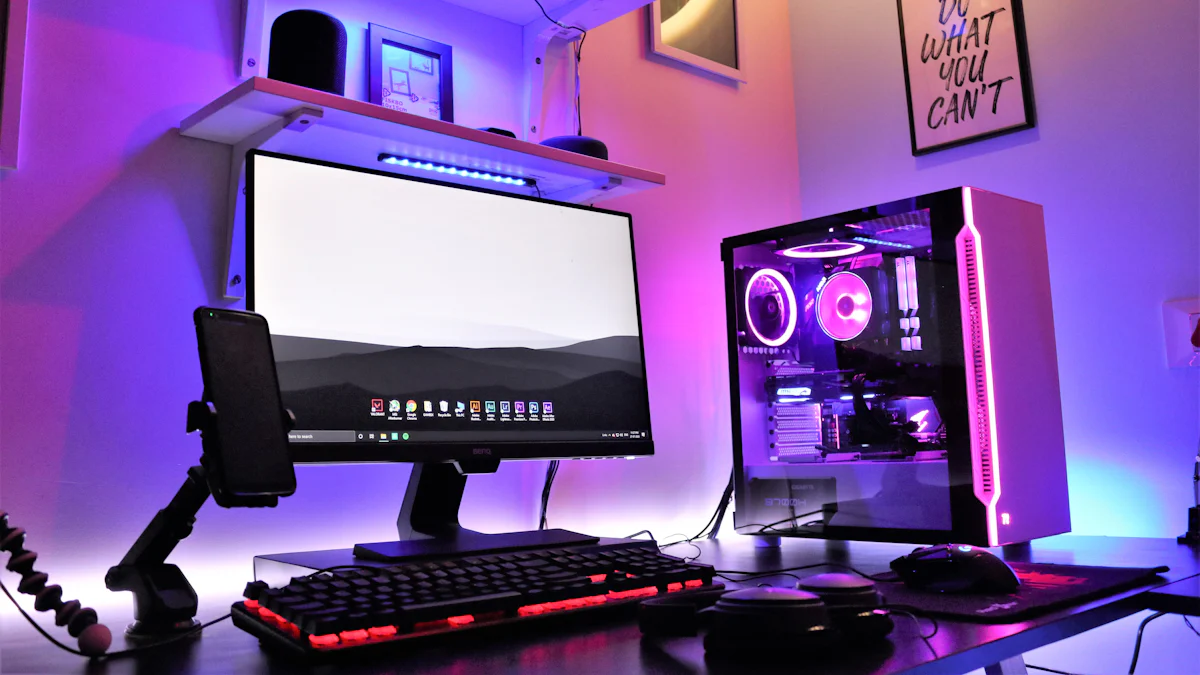
When selecting the right RGB LED strip, understanding the different types available is essential. Each type offers unique features and benefits, catering to various lighting needs and preferences. Below, we explore the most popular options to help you make an informed decision.
Standard RGB LED Strips for Versatile Color Options
Standard RGB LED strips are the go-to choice for creating vibrant and customizable lighting. These strips combine red, green, and blue LEDs to produce a wide range of colors. By adjusting the intensity of each LED, you can achieve countless multicolor effects. These strips are ideal for accent lighting, under-cabinet illumination, or adding a splash of color to your living space.
The simplicity of standard RGB strips makes them user-friendly and cost-effective. They work well for both beginners and professionals looking to enhance their spaces with high-quality LED strips. Whether you want to create a cozy ambiance or a lively atmosphere, these strips provide the flexibility to suit your needs.
RGBW LED Strips for High-Quality LED Strip Lights
For those seeking high-quality LED strip lights with enhanced functionality, RGBW LED strip lights are an excellent option. These strips include an additional white LED alongside the red, green, and blue LEDs. The white LED delivers true white illumination, which is perfect for tasks requiring clarity and precision.
With RGBW LED strip lights, you can seamlessly switch between vibrant multicolor effects and natural white lighting. This versatility makes them suitable for both decorative and functional purposes. Use them in kitchens, offices, or any space where you need a balance of aesthetics and practicality. Their ability to produce a broader range of colors and hues ensures superior quality and performance.
Addressable LED Strips for Dynamic Lighting Effects
If you want to take your lighting to the next level, consider addressable LED strip lights. These advanced strips allow you to control each LED individually, enabling intricate patterns and dynamic effects. You can program them to display animations, gradients, or even synchronized light shows.
Addressable strips are perfect for creative projects, entertainment spaces, or events where you want to captivate your audience. Their integrated drivers ensure precise control over brightness and color, offering unmatched customization. These LED strips are a favorite among tech enthusiasts and professionals who demand cutting-edge lighting solutions.
By understanding the unique features of each type, you can choose the best LED strip lights for your specific needs. Whether you prioritize versatility, high-quality LED strips, or advanced dynamic effects, there’s an option that fits your vision.
Key Features to Consider When Choosing an RGB LED Strip
When selecting the ideal LED strips for your space, understanding their key features ensures you make an informed decision. These features directly impact the performance, durability, and overall satisfaction of your lighting setup.
Brightness and Lumens for Optimal Illumination
The brightness and light output of an RGB LED strip play a crucial role in achieving the desired ambiance. Measured in lumens, brightness determines how well the strip illuminates your space. Higher lumen values provide brighter light, making them suitable for task lighting or large areas. Lower lumen values create a softer glow, perfect for accent lighting or mood enhancement.
You should also consider the brightness levels offered by the strip. Adjustable brightness allows you to customize the lighting intensity based on your needs. For example, dimmable LED strip lights let you switch between vibrant illumination and subtle lighting with ease. Always check the product specifications to ensure the strip meets your quality and brightness requirements.
Color Range and CRI for Accurate Lighting
The color range of an RGB strip determines its ability to produce various hues. High-quality LED strips offer a wide spectrum of colors, enabling you to create dynamic and visually appealing effects. Some advanced strips even include cutting and length customization, allowing you to tailor the strip to fit your specific design.
Color Rendering Index (CRI) is another critical factor. A higher CRI ensures that the colors appear more natural and accurate under the light. This feature is especially important for spaces where color precision matters, such as art studios or retail displays. Opt for LED strip lights with a CRI of 80 or above for the best results.
Waterproofing and IP Ratings for Durability
For outdoor or wet-area installations, choosing a waterproof LED strip is essential. These strips come with protective coatings that shield the LEDs from moisture, dust, and other environmental factors. The Ingress Protection (IP) rating indicates the level of protection offered. For instance, an IP65-rated strip resists water splashes, while an IP68-rated strip can withstand submersion.
Waterproof versions of LED strips ensure durability and long-lasting performance in challenging conditions. They are ideal for patios, bathrooms, or kitchens where exposure to water is common. Always match the IP rating to your installation environment to guarantee safety and reliability.
By focusing on these features—brightness, color accuracy, and waterproofing—you can select LED strips that align with your needs. Whether you prioritize vibrant illumination, precise color rendering, or robust durability, understanding these aspects helps you achieve the perfect lighting solution.
Power Requirements for Efficient Performance
Understanding the power requirements of an RGB LED strip is essential for ensuring efficient and reliable performance. The power supply directly impacts the functionality, longevity, and safety of your lighting setup. To make the right choice, you need to evaluate the strip’s voltage, wattage, and compatibility with your power source.
Determine the Voltage
Most LED strips operate on either 12V or 24V DC. Check the product specifications to confirm the required voltage. Using the wrong voltage can damage the strip or reduce its lifespan. If your power source doesn’t match the strip’s voltage, you may need a compatible transformer or adapter.Calculate the Wattage
Each LED strip consumes a specific amount of power, measured in watts per meter. Multiply the wattage per meter by the total length of the strip to determine the overall power consumption. For example, a 5-meter strip consuming 10 watts per meter will require a power supply capable of delivering at least 50 watts.Choose a Suitable Power Supply
Select a power supply that exceeds the total wattage of your LED strip by at least 10%. This buffer ensures stable operation and prevents overheating. For instance, if your strip requires 50 watts, opt for a power supply rated at 55 watts or higher. This approach enhances efficiency and extends the lifespan of both the strip and the power supply.Check Compatibility with Control Systems
If your LED strip includes features like dimming or addressable lighting, ensure the power supply is compatible with the control system. Some advanced strips require specific drivers or controllers to function correctly. Verify these requirements before purchasing to avoid compatibility issues.Consider Energy Efficiency
High-quality LED strips are designed to consume less power while delivering optimal brightness. Look for energy-efficient options that align with your lighting needs. Efficient strips not only reduce electricity costs but also minimize heat generation, contributing to a safer and more sustainable setup.
By carefully assessing the voltage, wattage, and compatibility of your LED strip, you can create a lighting system that performs efficiently and reliably. Proper power management ensures your setup remains functional, safe, and cost-effective over time.
How to Choose the Right LED Strip for Your Installation Environment
Selecting the right LED strips for your installation environment ensures optimal performance and longevity. Different spaces demand specific features to meet their unique requirements. Below, you’ll find guidance on choosing the best LED strip lights for indoor, outdoor, and wet-area applications.
Indoor Installations for Home and Office Spaces
For indoor spaces like homes and offices, LED strip lights offer a versatile and energy-efficient solution. These strips enhance ambiance, provide task lighting, and add decorative accents. When choosing indoor LED strips, focus on brightness, color accuracy, and ease of installation.
Brightness and Color Options
Opt for strips with adjustable brightness to suit different activities. For example, brighter settings work well for workspaces, while dimmer settings create a cozy atmosphere in living rooms. Ensure the strips offer a wide range of colors to match your interior design and mood preferences.Ease of Installation
Look for LED strips with adhesive backing for quick and hassle-free setup. Flexible strips can adapt to various surfaces, including walls, ceilings, and furniture. Ensure the strips are compatible with your existing power supply and control systems for seamless integration.Energy Efficiency
Indoor LED strip lights consume significantly less energy than traditional lighting options. According to research, RGB LED strips use 75% less energy and last 25 times longer than incandescent bulbs. This efficiency reduces electricity costs and supports sustainability.
By selecting high-quality LED strips tailored to your indoor needs, you can create a functional and visually appealing environment.
Outdoor Installations for Weather-Resistant Lighting
Outdoor installations require LED strip lights designed to withstand environmental challenges. These strips enhance patios, gardens, and pathways with vibrant and durable lighting solutions.
Waterproofing and IP Ratings
Choose waterproof LED strips with a high IP rating for outdoor use. An IP65 rating protects against water splashes, while IP68-rated strips can handle full submersion. These features ensure durability in rain, humidity, and other weather conditions.Durability and Longevity
Outdoor LED strips must endure temperature fluctuations and UV exposure. High-quality components, such as robust LED chips and protective coatings, enhance performance and longevity. Research shows that superior materials directly impact the reliability of LED strips.Power Supply Considerations
Outdoor setups often require longer strips, which consume more power. Calculate the total wattage and select a power supply with at least a 10% buffer to ensure stable operation. This approach prevents voltage drops and maintains consistent brightness.
With the right LED strips, you can transform your outdoor spaces into inviting and well-lit areas, perfect for relaxation or entertainment.
Wet Areas for Safe and Reliable Illumination
Wet areas, such as bathrooms, kitchens, and poolsides, demand LED strip lights that prioritize safety and reliability. Proper selection ensures these strips perform effectively in moisture-prone environments.
Safety Features
Waterproof LED strips with protective coatings prevent water damage and electrical hazards. Always verify the IP rating to match the level of exposure. For instance, IP68-rated strips are ideal for areas with direct water contact, such as pools or showers.Brightness and Color Accuracy
Wet areas often require bright and accurate lighting for tasks like cooking or grooming. Strips with high lumen output and a Color Rendering Index (CRI) above 80 provide clear and natural illumination. This ensures colors appear true to life, enhancing functionality and aesthetics.Energy Efficiency
Energy-efficient LED strips reduce electricity consumption without compromising performance. Studies highlight that RGBW strips achieve better color balance with lower energy use, making them an excellent choice for wet areas.
By choosing waterproof and energy-efficient LED strips, you can illuminate wet areas safely and effectively, ensuring both functionality and style.
Practical Tips for Installing and Maintaining LED Strip Lights
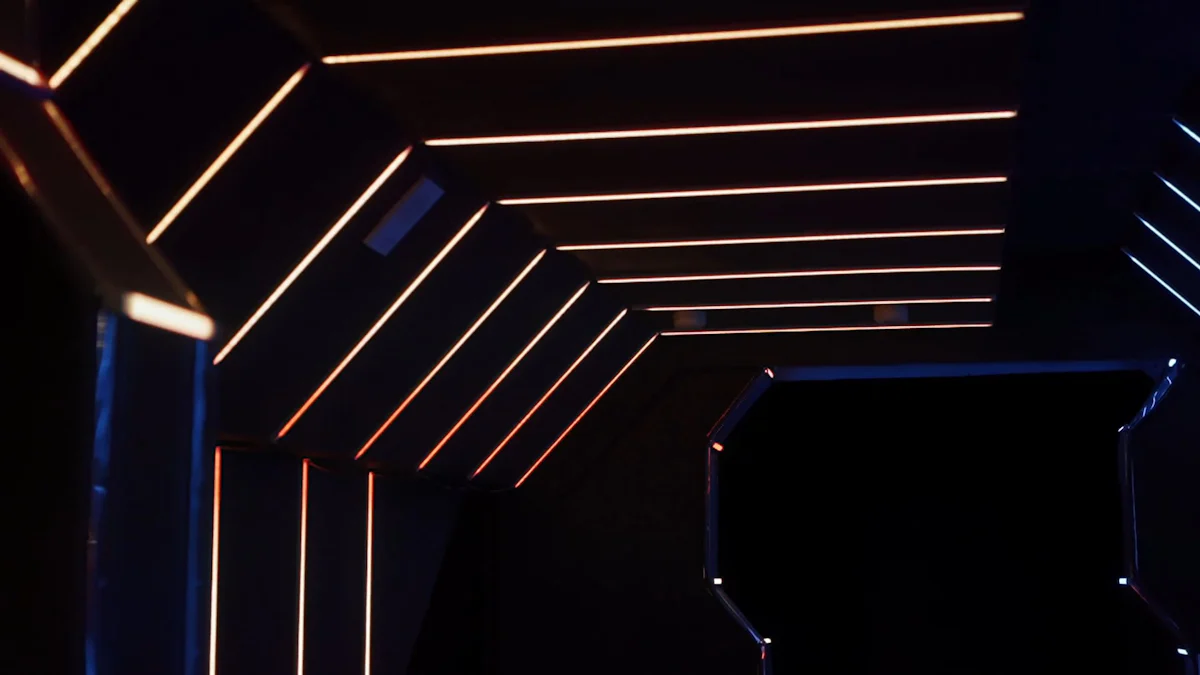
Proper installation and maintenance of LED strip lights ensure their longevity and optimal performance. By following these practical tips, you can create a seamless lighting setup while minimizing potential issues.
Installation Tips for Seamless Setup
A successful installation begins with preparation and attention to detail. Follow these steps to achieve a smooth and efficient setup:
Measure the Space
Accurately measure the area where you plan to install the LED strip. This ensures you purchase the correct length and avoid unnecessary cutting or wastage.Clean the Surface
Before attaching the strip, clean the surface thoroughly to remove dust and grease. A clean surface allows the adhesive backing to stick securely, preventing the strip from peeling over time.Plan the Layout
Map out the placement of the strip, power supply, and connectors. This step helps you avoid last-minute adjustments and ensures a neat and organized installation.Use Mounting Accessories
For areas where adhesive backing may not suffice, consider using mounting clips or channels. These accessories provide additional support and enhance the strip’s durability.Test Before Finalizing
Always test the LED strip before securing it in place. Connect it to the power supply and check for any defects or inconsistencies in brightness. Testing saves time and effort by identifying issues early.
By following these tips, you can achieve a professional-looking installation that enhances your space with minimal hassle.
Power Supply Selection for Reliable Operation
Choosing the right power supply is crucial for the safe and efficient operation of your LED strip lights. Here’s how to make the best choice:
Match the Voltage
Verify the voltage requirements of your LED strip, typically 12V or 24V. Using an incompatible voltage can damage the strip or reduce its lifespan.Calculate the Wattage
Determine the total wattage of your LED strip by multiplying the wattage per meter by the strip’s length. Select a power supply that exceeds this value by at least 10% to ensure stable performance.Consider Outdoor Use
For outdoor installations, choose a waterproof power supply with an appropriate IP rating. This protects the system from moisture and environmental factors.Check Compatibility with Controllers
If your LED strip includes dimming or addressable features, ensure the power supply supports these functionalities. Compatibility prevents operational issues and enhances the strip’s performance.
A reliable power supply not only ensures the safety of your setup but also extends the lifespan of your LED strip lights.
Maintenance and Troubleshooting for Longevity
Regular maintenance keeps your LED strip lights functioning at their best. Follow these practices to prolong their lifespan:
Clean Regularly
Dust and debris can accumulate on the strip, dimming its brightness. Use a soft cloth or brush to clean the surface gently, especially in high-traffic or outdoor areas.Inspect Connections
Periodically check the connections between the strip, power supply, and controllers. Loose or damaged connections can cause flickering or uneven lighting.Protect from Moisture
For installations in wet areas, ensure the strip and power supply are adequately shielded. Waterproof coatings and high IP ratings provide essential protection against water damage.Address Issues Promptly
If you notice any irregularities, such as flickering or reduced brightness, troubleshoot immediately. Common issues include loose connections, insufficient power supply, or damaged sections of the strip.Avoid Overheating
Ensure proper ventilation around the strip and power supply to prevent overheating. Overheating can reduce the efficiency and lifespan of your LED lights.
By maintaining your LED strip lights and addressing issues promptly, you can enjoy consistent performance and vibrant illumination for years to come.
Selecting the right RGB LED strip transforms your space with vibrant and functional lighting. By focusing on the type, features, and installation environment, you ensure the strip meets your specific needs. Evaluate factors like brightness, color accuracy, and waterproofing to match your preferences. Proper installation and maintenance enhance performance and extend the lifespan of your LED setup. Use a compatible power supply to prevent voltage drops and ensure reliable operation. With thoughtful planning and care, your LED lighting system will deliver stunning results and long-lasting satisfaction.
FAQ
What are RGB LED strips, and how do they work?
RGB LED strips are flexible lighting solutions that use red, green, and blue LEDs to produce a wide range of colors. By adjusting the intensity of each LED, you can create various hues and effects. These strips often come with controllers that allow you to change colors, brightness, and patterns, making them versatile for decorative and functional lighting.
How do I install RGB LED strips correctly?
To install RGB LED strips, follow these steps:
Measure the Area: Determine the length of the strip needed for your space.
Prepare the Surface: Clean the surface to ensure the adhesive backing sticks securely.
Plan the Layout: Map out the placement of the strip, power supply, and connectors.
Attach the Strip: Peel off the adhesive backing and press the strip onto the surface.
Connect to Power: Attach the strip to the power supply and test it before finalizing the setup.
Proper installation ensures the strip functions effectively and lasts longer.
Can I cut RGB LED strips to fit my space?
Yes, most RGB LED strips can be cut to fit your space. Look for designated cutting points marked on the strip, usually indicated by a scissor icon. Use sharp scissors to make a clean cut at these points. Cutting outside these marks can damage the strip and affect its functionality.
Are RGB LED strips safe for outdoor use?
Some RGB LED strips are designed for outdoor use. Check the IP rating to determine their level of protection against water and dust. For outdoor installations, choose strips with at least an IP65 rating for splash resistance or IP68 for full submersion. Always pair them with a waterproof power supply for added safety.
How do I choose the right power supply for my RGB LED strip?
To select the right power supply:
Check Voltage: Match the strip’s voltage (12V or 24V) with the power supply.
Calculate Wattage: Multiply the strip’s wattage per meter by its length. Add a 10% buffer to the total wattage for stable operation.
Ensure Compatibility: Verify that the power supply supports any additional features like dimming or addressable lighting.
A suitable power supply ensures efficient and reliable performance.
How do I maintain RGB LED strips for long-lasting performance?
Regular maintenance keeps your RGB LED strips in top condition:
Clean the Strips: Wipe them gently with a soft cloth to remove dust and debris.
Inspect Connections: Check for loose or damaged connections periodically.
Protect from Moisture: Use waterproof strips in wet areas to prevent damage.
Avoid Overheating: Ensure proper ventilation around the strip and power supply.
Following these practices prolongs the lifespan of your LED strips.
Can I control RGB LED strips with my smartphone?
Yes, many RGB LED strips come with smart controllers that connect to your smartphone via Wi-Fi or Bluetooth. These controllers allow you to adjust colors, brightness, and patterns through an app. Some systems also integrate with voice assistants like Alexa or Google Assistant for hands-free control.
What is the difference between RGB and RGBW LED strips?
RGB LED strips use red, green, and blue LEDs to create colors, while RGBW strips include an additional white LED. The white LED in RGBW strips provides true white light, making them ideal for tasks requiring clarity. RGB strips are better suited for decorative purposes, while RGBW strips offer more versatility for both functional and aesthetic lighting.
Why do my RGB LED strips flicker or dim?
Flickering or dimming often occurs due to:
Insufficient Power Supply: Ensure the power supply meets the strip’s voltage and wattage requirements.
Loose Connections: Check all connections between the strip, power supply, and controller.
Overloaded Circuit: Avoid connecting too many strips to a single power source.
Addressing these issues promptly restores proper functionality.
Can I reuse RGB LED strips after removing them?
Reusing RGB LED strips depends on their condition after removal. If the adhesive backing remains intact and the strip is undamaged, you can reapply it using mounting clips or double-sided tape. However, excessive bending or cutting during removal may compromise its performance. Always handle the strips carefully to maximize their reusability.
See Also
Selecting The Perfect LED Strip Lights For Linear Lighting
Effective Installation Tips For RGB LED Strip Lights
Top Five Tips For Choosing The Best LED Strips
